Familia: Polytrichaceae → Genus: Atrichum → Species: Atrichum undulatum
Genus name: Atrichum (Polytrichaceae) • タチゴケ属 • tachi-goke zoku (‘zoku’ means ‘genus’, ‘goke’ is ‘moss’) •
About genus: Atrichum is a moss from the family of Polytrichaceae, very common on soil banks and other areas of exposed mineral soil. This genus consists of upright unbranched stems with narrow undulate (wavy) leaves with toothed margins. Beneath the soil it has a creeping root-like structure from which rise the numerous simple erect 2-5cm tall stems. The genus contains about 20- 50 species, which are common in Europe, Asia, America, Africa and Australia.
The name Atrichum is derived from the Greek a = negation and trichos = hair and refers to the bald kalyptra (tissue/veil that protects the capsule containing the sporophyte).
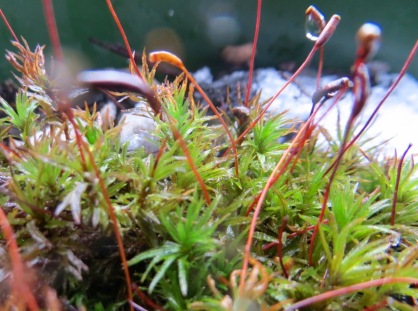
2/6/17 Atrichum undulatum
Species description: Atrichum undulatum • ナミガタタチゴケ • namigata tachi-goke. In Japan it grows on Hokkaido, Honshu, Shikoku, Kyushu.
Also known as Catherine’s moss or Wavy Catharinea in many European countries, and ‘Żurawiec falisty’ in Polish, which literally means Wavy Crane-like Moss.
Synonym(s): Polytrichum undulatum (j. Hedwig)

SJG • 2/14/17 – A. undulatum around the steps to the Tea House Garden, along the West path – the brown above the steps is multitude os brown capsules, the green close to steps is actual folliage
Atrichum undulatum is a small to fairly large moss that can form extensive patches, usually dark green, but sometimes light green or yellowish when well-lit. The erect stems reach 5-7 cm, with leaves to 1 cm in length and are strongly crisped when dry. The leaves have up to seven plates of tissue running longitudinally up the leaf. Leaves are sparse below, more crowded above, with toothed leaf edges. The reddish-brown seta (stalk) holds brown capsule (the spore bearing structure of a moss), which is cylindrical and curved (sometimes almost horizontal), with a long beak on the lid. Capsules mature spring-summer (Apr- Jul).
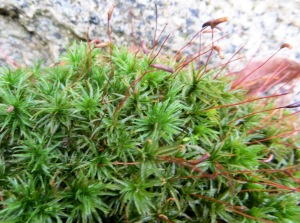
SJG • 2/14/17 – Close up from the picture above – A. undulatatum on the steps to roji
Cylindrical capsules are frequent, 3 to 4 mm long with a long weak beak of similar length, on a 2 to 4 cm long reddish seta.
Habitat: Usually found in shaded, well-drained woodlands on all but the most extreme soils. Grows in dry weedy habitats, especially roadside ditches; usually low elevations. Evidently introduced from Europe.
Distribution: Atrichum undulatum is among the largest European terrestrial moss species. It is widespread across Europe, and due to its size is widely used in moss biology research. It also grows in North America and Asia (China, Japan, Kazachstan, Philippines, Russia, Taiwan).
[How many Atrichum species in WA state? – check on Friday]
SJG notes: If Seattle Japanese Garden would ever get overgrown by moss, it would

SJG • 6/14/15 – huge mat of A. undulatum under the evergreen oaks in S
probably become Atrichum undulatum moss garden. This fairly big and exceptionally beautiful star-shaped moss with translucent green leaves grows in nearly every shady place of our Garden. It is our most prevalent moss that is juicy green half of the year, and appearing ‘blooming’ when its reddish-brown stalks hold dark brow mature capsules the other half (spring and summer).
Lots of it grows right at the entrance to roji (Tea House garden), around the stepping stones leading to machiai (well visible from the West
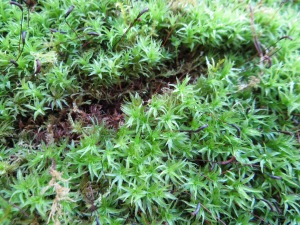
SJG • 6/14/15 – close-up of the moss from the picture above in area S: made a criss to show how the plants have only a few leaves at the bottom, tufting towards the top
path), but there is also abundance of it in nearly every other area of the Garden: along the East path in D, G and I, a huge mat under the evergreen oaks in S and along the Service Road (ZZE & ZZW).
Spore releasing time for Atrichum undulatum in our Garden – mid February: while taking the pics for this post on 2/14/17 noticed that the very charachteristic long operculum (lid/flap which controls release of the spores) was absent on most of the capsules – it usually falls off when the moss is ready to release the spores – and when accidentally brushed the capsules they released the spores, indeed.
What’s in the name: search for the meaning of common names of Atrichum revealed interesting information, shared below.
A fellow guide Cara Izumi, who researches and translates the Japanese common names for this blog and who has background in linguistics, wrote this about the genus name:
‘タチゴケ属 – tachi-goke zoku. ‘Zoku’ means ‘genus’, ‘goke’ is ‘moss’, and it looks like ‘tachi-goke’ is a phonetic kana-ization, or could be the other way around. If it’s a Japanese word, it could have a meaning of ‘standing’.
And this about species name:
ナミガタタチゴケ – namigata tachi-goke. The second word was in the previous name, and ‘namigata’ is an expression (compound noun) with ‘nami’ usually meaning ‘wave’ or ‘row’ when used for natural shapes, so for example a row of trees is called a ‘namiki’, with ‘ki’ meaning trees. ‘Nami’ can also refer to something that’s normal, or average. ‘Gata’ in this case I’m pretty sure means ‘in the style of’.
This all make sense, as Atrichum is an upright/erect (Acrocarpous) moss and its ‘wavy’ leaf pattern is congruent with names often used in many other cultures (also in Polish name – ‘wavy crane-like moss’).
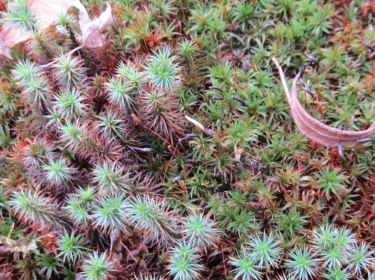
SJG • 2/14/16 – Polytrichum moss (light green, spiky on the L) next to A. undulatum (R)
Search for etymology of the crane’s presence in the Polish common name of A. undulatum revealed nothing apart from the fact that many mosses do have common name in Polish, usually descriptive of appearance or comparing to other things in nature; as well as the fact that scientific taxonomy (in Latin) is used side by side with a Polish one.
Various Atrichum species are often called crane’s bill moss because the operculum (lid/flap) on the moss capsule looks supposedly like a crane’s bill. The name wavy-leaved crane’s bill moss has been applied to several species, esp. Atrichum crispum (a moss of the eastern US and parts of Canada, as well as China and Japan) and Atrichum undulatum (a moss of Europe, Asia and Africa).
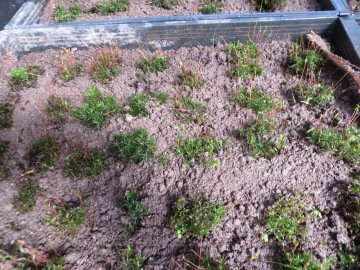
8/25/16 – WA Arboretum nursery: our gardeners cultivate A. undulatum on trays
In many European countries, where the Atrichum undulatum is widely spread and probably originates from, is called Catherine’s moss, named so in the late 1700’s by a German botanist Jakob Friedrich Ehrhart in honor of the Russian tsarina Catherine II.
The name was changed several times at the beginning of 1800’s – to Polytrichum undulatum by Hedwig, then to Catharinea undulata by Friedrich Weber and Daniel M. H. Mohr and finally to Atrichum undulatum by Palisot de Beauvois – yet it’s still referred to as Catherine’s moss today, even in academic research (see link in References and related reading below).
Polish species name: żurawiec falisty
References and related reading:
• Concise write-up with pictures + interesting note about A.undulatum being widely misunderstood, from DiscoverLife.org – a multi-academic web project
• Very clear up-close picture of Catherine’s Moss from INaturalist.org – an online social network of people sharing biodiversity information and also an internationally crowdsourced species identification system
• Good Atrichum undulatum’s image of capsule from Encyclopedia of Life
• 2016 research paper from The National Center for Biotechnology on features of A. undulatum, a desiccation-tolerant plant in drought conditions, which are an increasingly important limitation on plant productivity worldwide
• Interesting collective research paper on successful establishing the Catherine’s moss in in vitro conditions from University of Belgrade, University of Cologne and University of Bonn
• Literary reference – mostly for moss gardeners:
1.) In ‘The Magical World of Moss Gardening’ by Annie Martin on page 105 the author says that ‘Atrichum undulatum can be aggressive, with rapid growth achieving full coverage in six month to a year […]. She recommends this species for stone path or patios, because even with the plants going through normal rusty brown stage, the new growth is always lush and vigorous.
2.) George Schenk concurs in his 1997 book ‘Moss Gardening. Including Lichens, Liverworts and Other Miniatures’. On page 83 he writes that even after the soil was poisoned by chemical killers of weeds and grass (like Roundup) ‘the invaluable carpeting moss Polytrichum, and also Pohlia and Atrichum, are especially apt as first comers in soil cleared by poisoning’. Sadly, he recommends such poisoning as ground preparation for growing mosses, although ‘as chemically-shy gardener, I do so with some reluctance’, he adds… To his credit his ‘second method is the establishing of a moss carpet by encouraging mosses already present […], on p. 84. Hopefully now, 20 years after the book’s publication, the second method is what an environmentally conscious gardener would choose.

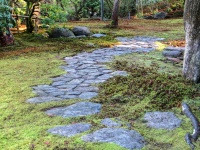
Pingback: Atrichum (Polytrichaceae) – life of plants